
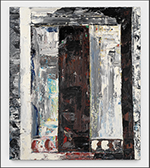

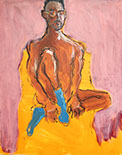
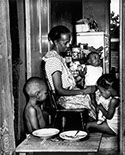
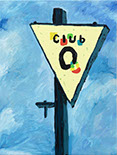
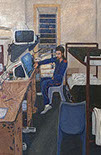
“Free Your Mind: Art and Incarceration in Michigan”
Mike Kelley’s Mobile Homestead, MOCAD
April 14–September 10, 2023
by Marissa Jezak
Distant memories, imaginative fantasy, juxtaposed with a severe reality, collectively inspire “Free Your Mind: Art and Incarceration in Michigan,” a diverse showcase consisting mainly of two-dimensional art by individuals currently or previously incarcerated in Michigan prisons. Co-curated by Steven L. Bridges and Janie Paul, the show opened April 14th, and ran through September 10th of 2023. The artworks depict scenes of day-to-day life in lock-up, men sitting in groups playing cards and chess, passing the time. Some pictures reflect a more introspective personal narrative with elaborate illustrations evoking intense mental suffering, anguish. The intensity and crowdedness, the feelings of confinement and conflict portrayed in the imagery contrast starkly with the comfortable domestic setting in MOCAD’s Mobile Homestead, a separate addition to the museum which was designed as an exact replica of artist Mike Kelley’s suburban childhood home. Through the living room, dining room, and narrow hallways of this small “home,” visitors encounter the creations of artists who have lost precisely that—home, at least temporarily.
Walking up the driveway to the gallery, yellow yard signs display statistics such as “At least 20% of Michigan’s incarcerated population has been identified to have a mental health disorder,” setting the tone for the exhibition ahead, which clearly intends to educate viewers regarding the subject of incarceration. Beginning in the garage section of the homestead, a table displays dozens of ’zines full of drawings and poetry, collaborations from workshops made up of college students from Michigan State University and inmates from local penitentiaries. Also, in the room is a film and two paintings, which transition smoothly into the rest of the show. In Rehabilitation, an acrylic painting by Phillip Crowley, two prisoners are depicted behind bars in a haunted cell, surrounded by ghosts and what appears to be Jesus on the cross. A large clock divides the two figures, with the scales of justice below it, holding two books, one of which reads “God’s Law.” The resemblance between the men, one appearing young and the other old, combined with the symbol of the clock, infers the artist may be referencing the long passing of time and aging process that’s happening to him on the inside. (The controversial length of prison sentences is another point raised by the informational plaques throughout the show.)
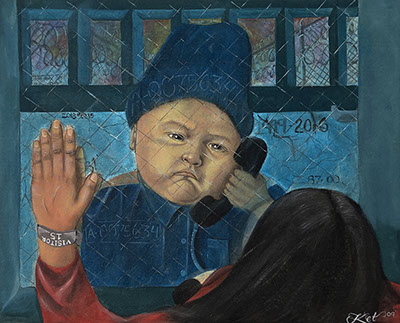
(Left) Dara Ket, Why My Baby?, 2009. Acrylic on stretched canvas. Collection of Janie Paul. Photo: Marissa Jezak.
(Right) John Lonchar, Our Cell, 2008. Acrylic on canvas board. Collection of Janie Paul. Photo: Marissa Jezak.
Descriptions next to the artworks communicate that many of the artists were employed in skilled trades prior to their imprisonment. This fact is demonstrated in the special attention to detail and technical accuracy visible in the works. The exhibition represents a blend of genders among its artists, including a mix of men and women. A wall text elaborates on the incarceration of women specifically, stating, that in recent years, the percentage of women being locked up has steadily increased, as well as have the lengths of their sentences. The text highlights the fact that women’s biology can make their time served harder to bear due to childbirth, breastfeeding, motherhood, and dealing with menstrual cycles. In the painting, Why My Baby? Dara Ket addresses the pain felt by a mother whose child has been locked away. The child, strikingly depicted as an infant, is dressed in a prison uniform and is shown talking to its mother through the wired glass visitation window. In the artist’s statement, Ket speaks from the heart, “This painting is dedicated to those that are in prison for the rest of their lives and not going home. I feel their pain. I feel the number on their shoulder, not knowing when you’re going home. You can’t put it in words to know that you’re gonna die in prison.” Similarly, a father’s perspective of this scenario is drawn out in the family portrait, Father’s Responsibility by Samuel Hendley. In this painting, the artist depicted himself at home in his living room, holding a little girl, with another child and baby painted beside them—an idealized view of where he should be, as a protector of his home—not showing the reality of where he is now, in prison.
Coincidentally occurring at the same time that Detroit’s new Wayne County jail is being built, this exhibition not only draws attention to the problems of the prison system and the activists trying to change it, but more importantly connects the public to the humanity of the artists—the imprisoned people who are stripped of their personhood and reduced to a number or statistic, and used as pawns in political warfare—their exploitation fueling the grimy machine of capitalist greed that lies at the heart of the prison industrial complex. Throughout the show, the theme of suffering is heavily present, as it is intertwined with the experience of a dysfunctional criminal punishment that has been fabricated by our society. In these artworks, the sense of loneliness, scarcity, and pain is real. The hearts of the prisoners are displayed in a sensitive space of openness that demonstrates survival in its rawest form.
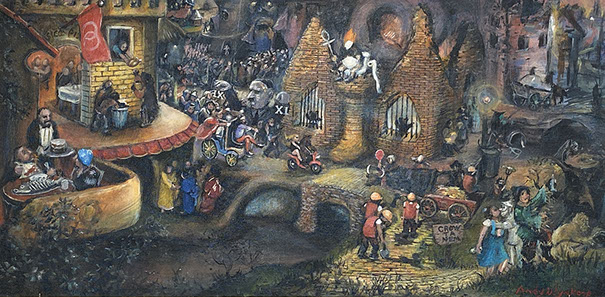
Andy Wynkoop, Economic Redistribution, 2012. Acrylic on canvas board. Collection of Janie Paul. Photo Marissa Jezak.
Marissa Jezak (b.1992, Harrison Township, MI) is an artist and writer based in Detroit. She earned a BFA in photography and critical theory from the College for Creative Studies in 2014. Marissa Jezak’s writing has been featured in publications such as Detroit Research and Runner, and she has exhibited artworks internationally. Her ongoing research focuses on illness, trauma, and gender politics.
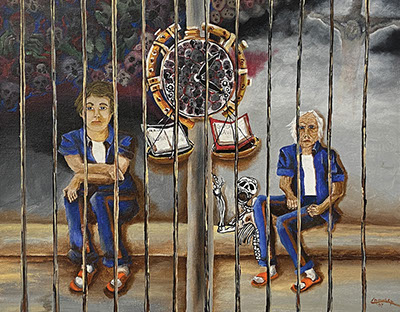
Phillip Crowley, Rehabilitation, 2008. Acrylic on canvas. Collection of Janie Paul. Photo: Marissa Jezak.
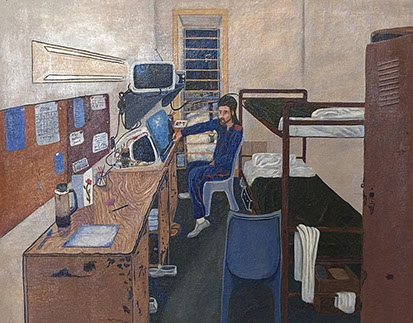
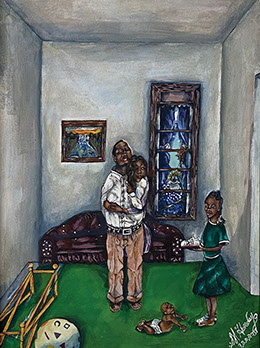
Samuel Hendley, Father’s Responsibility, 2019. Acrylic on canvas. Courtesy the artist and the Prison Creative Arts Project. Photo: Marissa Jezak.